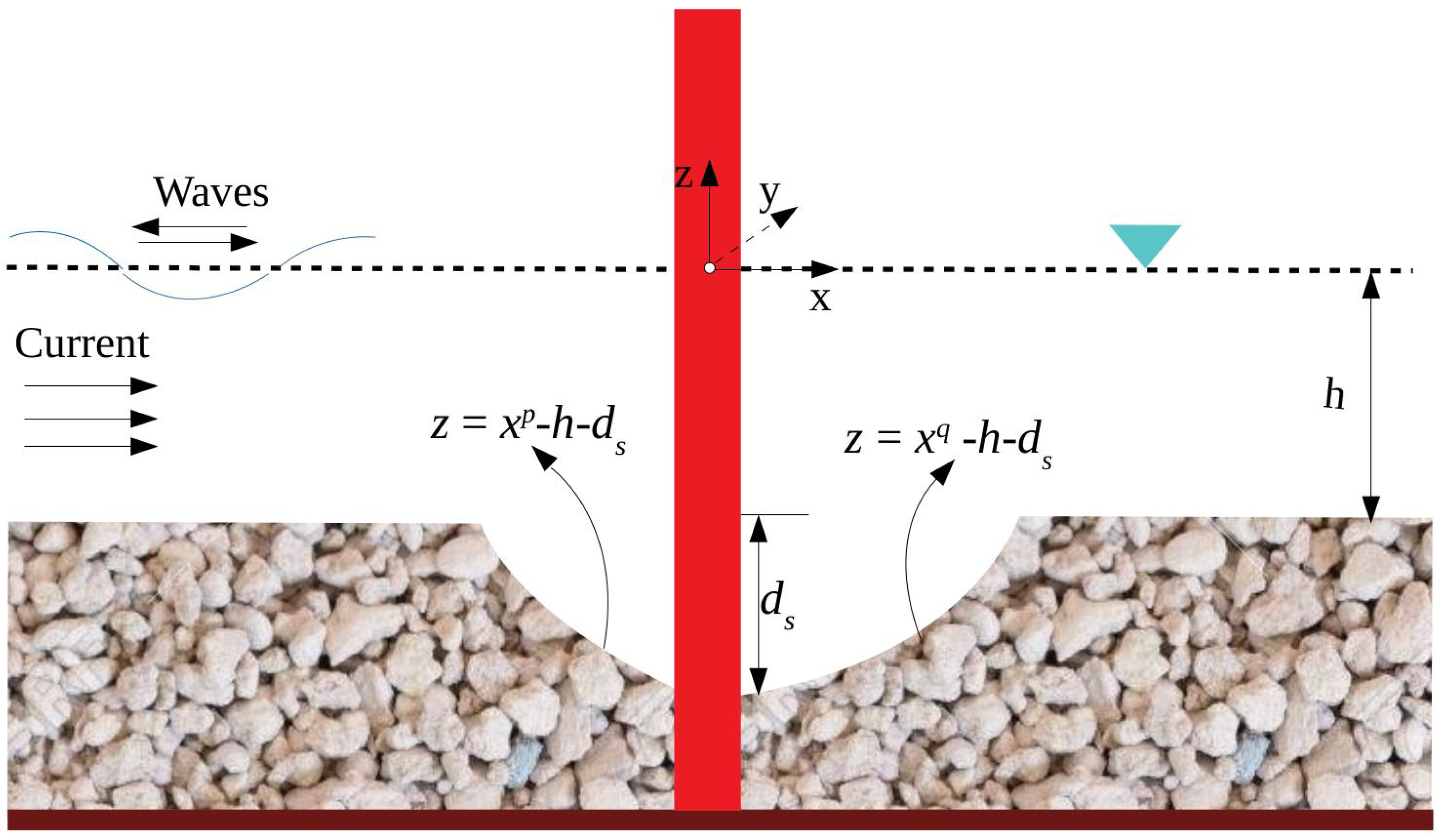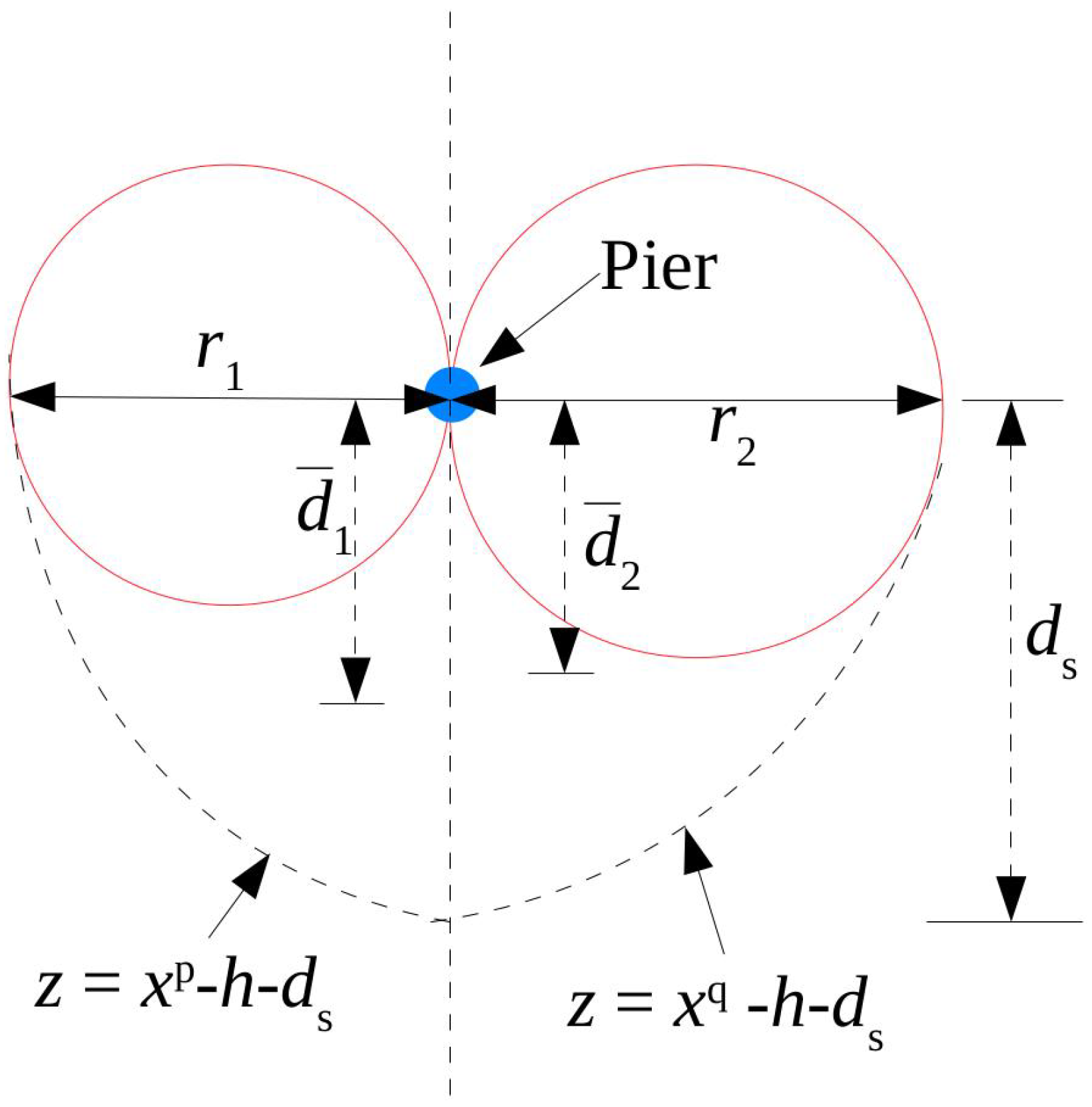The Equilibrium Scour Depth around a Pier under the Action of Collinear Waves and Current
Abstract
1. Introduction
2. Combined Wave and Current Velocity
3. Estimation of the Scour Depth
4. Validation and Discussion
5. Conclusions
Author Contributions
Funding
Acknowledgments
Conflicts of Interest
References
- Myrhaug, D.; Ong, M.C.; Føien, H.; Gjengedal, C.; Leira, B.J. Scour below pipelines and around vertical piles due to second-order random waves plus a current. Ocean Eng. 2009, 36, 605–616. [Google Scholar] [CrossRef]
- Dey, S.; Sumer, B.M.; Fredsøe, J. Control of scour at vertical circular piles under waves and current. J. Hydraul. Eng. 2006, 132, 270–279. [Google Scholar] [CrossRef]
- Sumer, B.M.; Fredsøe, J.; Christiansen, N. Scour around vertical vile in waves. J. Waterw. Port Coast. Ocean Eng. 1992, 118, 15–31. [Google Scholar] [CrossRef]
- Kobayashi, T.; Oda, K. Experimental study on developing process of local scour around a certical cylinder. In Coastal Engineering 1994; ASCE: Reston, VA, USA, 1995; pp. 1284–1297. [Google Scholar]
- Sumer, B.; Christiansen, N.; Fredsøe, J. Influence of cross section on wave scour around piles. J. Waterw. Port Coast. Ocean Eng. 1993, 119, 477–495. [Google Scholar] [CrossRef]
- Ninomiya, K.; Tagaya, K.; Murase, Y.; Murase, J. A study on suction and scouring of sit-on-bottom type offshore structure. In Proceedings of the Offshore Technology Conference, Houston, TX, USA, 1–3 May 1972. [Google Scholar]
- Wang, R.K.; Herbich, J.B. Combined Current and Wave-Produced Scour around a Single Pile; Department of Civil Engineering, Texas Engineering Experiment Station: College Station, TX, USA, 1983. [Google Scholar]
- Dey, S.; Bose, S.; Sastry, G. Clear water scour at circular piers, Part I: Flow model. In Proceedings of the 8th Congress IAHR Asian and Pacific Division, Pune, India, 20–23 October 1992; pp. 69–80. [Google Scholar]
- Dey, S.; Bose, S.; Sastry, G. Clear water scour at circular piers, part II: Design formula. In Proceedings of the 8th Congress IAHR Asian and Pacific Division, Pune, India, 20–23 October 1992; pp. 81–92. [Google Scholar]
- Dey, S. Three-dimensional vortex flow field around a circular cylinder in a quasi-equilibrium scour hole. Sadhana 1995, 20, 871–885. [Google Scholar] [CrossRef]
- Dey, S. Sediment pick-up for evolving scour near circular cylinders. Appl. Math. Model. 1996, 20, 534–539. [Google Scholar] [CrossRef]
- Dey, S. Local scour at piers, Part I: A review of developments of research. Int. J. Sediment Res. 1997, 12, 23–46. [Google Scholar]
- Myrhaug, D.; Holmedal, L.E.; Simons, R.R.; MacIver, R.D. Bottom friction in random waves plus current flow. Coast. Eng. 2001, 43, 75–92. [Google Scholar] [CrossRef]
- Raikar, R.; Dey, S. Scour of gravel beds at bridge piers and abutments. In Proceedings of the Institution of Civil Engineers-Water Management; Thomas Telford Ltd.: London, UK, 2005; Volume 158, pp. 157–162. [Google Scholar]
- Dey, S.; Raikar, R.V. Characteristics of horseshoe vortex in developing scour holes at piers. J. Hydraul. Eng. 2007, 133, 399–413. [Google Scholar] [CrossRef]
- Mutlu Sumer, B. Mathematical modelling of scour: A review. J. Hydraul. Res. 2007, 45, 723–735. [Google Scholar] [CrossRef]
- Raikar, R.V.; Dey, S. Kinematics of horseshoe vortex development in an evolving scour hole at a square cylinder. J. Hydraul. Res. 2008, 46, 247–264. [Google Scholar] [CrossRef]
- Ettema, R.; Melville, B.W.; Constantinescu, G. Evaluation of Bridge Scour Research: Pier Scour Processes and Predictions; Citeseer: Princeton, NJ, USA, 2011. [Google Scholar]
- Myrhaug, D.; Ong, M. Random wave-induced scour around marine structures using a stochastic method. In Marine Technology and Engineering; Guedes Soares, C., Garbatov, Y., Fonseca, N., Texeira, A.P., Eds.; CRC Press: Boca Raton, FL, USA, 2011. [Google Scholar]
- Myrhaug, D.; Ong, M.C. Scour around vertical pile foundations for offshore wind turbines due to long-crested and short-crested nonlinear random waves. J. Offshore Mech. Arct. Eng. 2013, 135, 011103. [Google Scholar] [CrossRef]
- Manes, C.; Brocchini, M. Local scour around structures and the phenomenology of turbulence. J. Fluid Mech. 2015, 779, 309–324. [Google Scholar] [CrossRef]
- Gazi, A.H.; Afzal, M.S.; Dey, S. Scour around piers under waves: Current status of research and its future prospect. Water 2019, 11, 2212. [Google Scholar] [CrossRef]
- Olsen, N.R.; Melaaen, M.C. Three-dimensional calculation of scour around cylinders. J. Hydraul. Eng. 1993, 119, 1048–1054. [Google Scholar] [CrossRef]
- Afzal, M.S.; Bihs, H.; Kamath, A.; Arntsen, Ø.A. Three-dimensional numerical modeling of pier scour under current and waves using level-set method. J. Offshore M. Arct. Eng. 2015, 137, 032001. [Google Scholar] [CrossRef]
- Ahmad, N.; Bihs, H.; Chella, M.A.; Arntsen, Ø.A.; Aggarwal, A. Numerical Modelling of Arctic Coastal Erosion Due to Breaking Waves Impact Using REEF3D. In Proceedings of the 27th International Ocean and Polar Engineering Conference, San Francisco, CA, USA, 25–30 June 2017; International Society of Offshore and Polar Engineers: Mountain View, CA, USA, 2017. [Google Scholar]
- Bouratsis, P.; Diplas, P.; Dancey, C.L.; Apsilidis, N. Quantitative spatio-temporal characterization of scour at the base of a cylinder. Water 2017, 9, 227. [Google Scholar] [CrossRef]
- Yang, Y.; Qi, M.; Li, J.; Ma, X. Evolution of hydrodynamic characteristics with scour hole developing around a pile group. Water 2018, 10, 1632. [Google Scholar] [CrossRef]
- Das, M. A Literature Review on Bed-Load Transport Due to Wave Action and Localized Scour in Non-Cohesive Sediments, Final Report HEL 21-6; University of California: Berkeley, CA, USA, 1970. [Google Scholar]
- Kawata, Y.; Tsuchiya, Y. Local scour around cylindrical piles due to waves and currents combined. In Coastal Engineering 1988; ASCE: Reston, VA, USA, 1989; pp. 1310–1322. [Google Scholar]
- Sumer, B.M.; Fredsøe, J. Scour around pile in combined waves and current. J. Hydraul. Eng. 2001, 127, 403–411. [Google Scholar] [CrossRef]
- Myrhaug, D.; Rue, H. Scour below pipelines and around vertical piles in random waves. Coast. Eng. 2003, 48, 227–242. [Google Scholar] [CrossRef]
- Cataño-Lopera, Y.A.; García, M.H. Geometry of scour hole around, and the influence of the angle of attack on the burial of finite cylinders under combined flows. Ocean Eng. 2007, 34, 856–869. [Google Scholar] [CrossRef]
- Ong, M.C.; Myrhaug, D.; Hesten, P. Scour around vertical piles due to long-crested and short-crested nonlinear random waves plus a current. Coast. Eng. 2013, 73, 106–114. [Google Scholar] [CrossRef]
- Forristall, G.Z. Wave crest distributions: Observations and second-order theory. J. Phys. Oceanogr. 2000, 30, 1931–1943. [Google Scholar] [CrossRef]
- Qi, W.G.; Gao, F.P. Physical modeling of local scour development around a large-diameter monopile in combined waves and current. Coast. Eng. 2014, 83, 72–81. [Google Scholar] [CrossRef]
- Chen, B.; Li, S. Experimental study of local scour around a vertical cylinder under wave-only and combined wave-current conditions in a large-scale flume. J. Hydraul. Eng. 2018, 144, 04018058. [Google Scholar] [CrossRef]
- Chen, B.; Li, S.W. Temporal variation of live-bed pier scour under combined wave-current flow in a large-scale flume. J. Coast. Res. 2019, 35, 348–356. [Google Scholar] [CrossRef]
- Gazi, A.H.; Afzal, M.S. A new mathematical model to calculate the equilibrium scour depth around a pier. Acta Geophys. 2019, 1–7. [Google Scholar] [CrossRef]
- Quezada, M.; Tamburrino, A.; Niño, Y. Numerical study of the hydrodynamics of waves and currents and their effects in pier scouring. Water 2019, 11, 2256. [Google Scholar] [CrossRef]
- Lamb, H. Hydrodynamics; Dover Publications: New York, NY, USA, 1945; 738p. [Google Scholar]
- Damen, J.M.; Van Dijk, T.A.G.P.; Hulscher, S.J. Spatially varying environmental properties controlling observed sand wave morphology. J. Geophys. Res. Earth Surface 2018, 123, 262–280. [Google Scholar] [CrossRef]
- King, E.; Conley, D.; Masselink, G.; Leonardi, N.; McCarroll, R.; Scott, T. The impact of waves and tides on residual sand transport on a sediment-poor, energetic and macrotidal continental shelf. J. Geophys. Res. Oceans 2019. [Google Scholar] [CrossRef]
- Soulsby, R.; Humphery, J. Field observations of wave-current interaction at the sea bed. In Water Wave Kinematics; Springer: Berlin, Germany, 1990; pp. 413–428. [Google Scholar]
- Romanoff, J.; Soares, C.G. Analysis and Design of Marine Structures; CRC Press: Boca Raton, FL, USA, 2013. [Google Scholar]
- Dey, S. Fluvial Hydrodynamics; Springer: Berlin, Germany, 2014. [Google Scholar]
- Hafez, Y.I. Mathematical modeling of local scour at slender and wide bridge piers. J. Fluids 2016, 2016. [Google Scholar] [CrossRef]


| Sl No. | Diameter of the Pier D (m) | Peak Frequency of Waves | Bed Orbital Velocity (m/s) | Un Disturbed Depth Averaged Current Velocity U (m/s) | Keulegan Carpenter Number | Sumer and Fredsøe [30]’s Data. | Proposed Model’s |
|---|---|---|---|---|---|---|---|
| 1 | 0.09 | 0.4 | 0.157 | 0.0 | 4 | 0.06 | 0.07 |
| 2 | 0.09 | 0.4 | 0.157 | 0.085 | 4 | 0.11 | 0.12 |
| 3 | 0.09 | 0.4 | 0.157 | 0.157 | 4 | 0.56 | 0.53 |
| 4 | 0.09 | 0.4 | 0.157 | 0.29 | 4 | 0.83 | 0.80 |
| 5 | 0.09 | 0.32 | 0.231 | 0.0 | 8 | 0.11 | 0.10 |
| 6 | 0.09 | 0.32 | 0.231 | 0.13 | 8 | 0.5 | 0.48 |
| 7 | 0.09 | 0.32 | 0.231 | 0.231 | 8 | 0.78 | 0.76 |
| 8 | 0.09 | 0.32 | 0.231 | 0.459 | 8 | 1.06 | 1.01 |
| 9 | 0.03 | 0.32 | 0.242 | 0.0 | 26 | 0.83 | 0.88 |
| 10 | 0.03 | 0.32 | 0.242 | 0.13 | 26 | 1.33 | 1.31 |
| 11 | 0.03 | 0.32 | 0.242 | 0.242 | 26 | 1.50 | 1.50 |
| 12 | 0.03 | 0.31 | 0.242 | 0.449 | 26 | 1.67 | 1.64 |
| 13 | 0.03 | - | - | 0.459 | - | 1.21 | 1.25 |
| 14 | 0.03 | - | - | 0.449 | - | 2 | 2.07 |
| Sl No. | Diameter of the Pier D (m) | Wave Time Period (S) | Bed Orbital Velocity (m/s) | Un Disturbed Depth Averaged Current Velocity U (m/s) | Keulegan Carpenter Number | Quezada et al. [39]’s Study | Proposed Model’s |
|---|---|---|---|---|---|---|---|
| 1 | 0.2 | 1.4 | 0.12 | 0.23 | 0.86 | 0.251 | 0.25 |
| 2 | 0.2 | 1.4 | 0.19 | 0.22 | 1.31 | 0.304 | 0.31 |
| 3 | 0.2 | 2 | 0.28 | 0.24 | 2.76 | 0.132 | 0.13 |
| 4 | 0.2 | 3 | 0.31 | 0.1 | 4.61 | 0.085 | 0.08 |
© 2020 by the authors. Licensee MDPI, Basel, Switzerland. This article is an open access article distributed under the terms and conditions of the Creative Commons Attribution (CC BY) license (http://creativecommons.org/licenses/by/4.0/).
Share and Cite
Gazi, A.H.; Purkayastha, S.; Afzal, M.S. The Equilibrium Scour Depth around a Pier under the Action of Collinear Waves and Current. J. Mar. Sci. Eng. 2020, 8, 36. https://doi.org/10.3390/jmse8010036
Gazi AH, Purkayastha S, Afzal MS. The Equilibrium Scour Depth around a Pier under the Action of Collinear Waves and Current. Journal of Marine Science and Engineering. 2020; 8(1):36. https://doi.org/10.3390/jmse8010036
Chicago/Turabian StyleGazi, Ainal Hoque, Subhrangshu Purkayastha, and Mohammad Saud Afzal. 2020. "The Equilibrium Scour Depth around a Pier under the Action of Collinear Waves and Current" Journal of Marine Science and Engineering 8, no. 1: 36. https://doi.org/10.3390/jmse8010036
APA StyleGazi, A. H., Purkayastha, S., & Afzal, M. S. (2020). The Equilibrium Scour Depth around a Pier under the Action of Collinear Waves and Current. Journal of Marine Science and Engineering, 8(1), 36. https://doi.org/10.3390/jmse8010036






